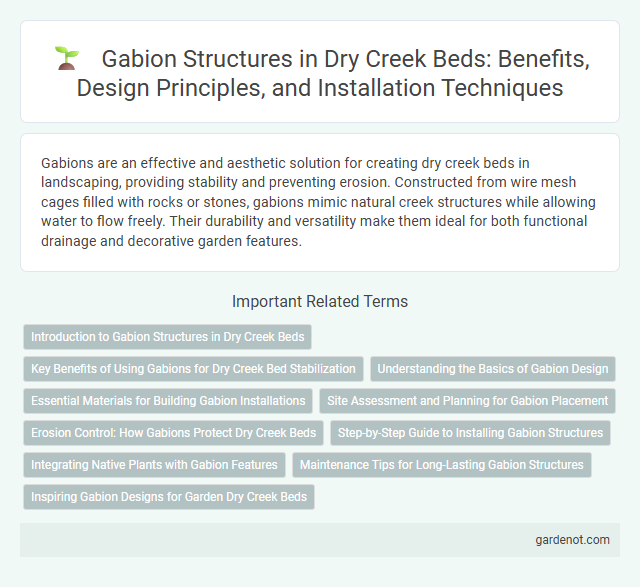Gabions are an effective and aesthetic solution for creating dry creek beds in landscaping, providing stability and preventing erosion. Constructed from wire mesh cages filled with rocks or stones, gabions mimic natural creek structures while allowing water to flow freely. Their durability and versatility make them ideal for both functional drainage and decorative garden features.
Introduction to Gabion Structures in Dry Creek Beds
Gabion structures in dry creek beds consist of wire mesh cages filled with rocks or stones, providing effective erosion control and slope stabilization. These permeable barriers allow water to flow through while trapping sediment, thereby reducing runoff velocity and preventing soil loss. Commonly used in civil engineering and landscape design, gabions blend functionality with natural aesthetics to enhance creek bed resilience.
Key Benefits of Using Gabions for Dry Creek Bed Stabilization
Gabions provide effective stabilization for dry creek beds by preventing soil erosion and controlling water flow through their durable wire mesh filled with rocks. Their permeability allows natural drainage while maintaining structural integrity, reducing the risk of flooding and sediment build-up. Gabions also offer ecological benefits by promoting vegetation growth and blending seamlessly into natural landscapes for long-term environmental stability.
Understanding the Basics of Gabion Design
Gabion design involves constructing wire mesh cages filled with rock, concrete, or soil to create durable retaining walls or erosion control structures in dry creek beds. Key factors include selecting corrosion-resistant materials, determining optimal cage size, and ensuring proper drainage through permeable fill to prevent water pressure buildup. Effective gabion systems stabilize slopes, reduce sediment transport, and blend naturally into the environment for sustainable creekbed management.
Essential Materials for Building Gabion Installations
Gabion installations require high-quality galvanized steel wire mesh to ensure durability and resistance to corrosion in dry creek bed environments. The mesh must be UV-resistant and have a welded, hexagonal, or square pattern to effectively contain stones or other infill materials, providing structural stability. Selecting angular, dense stones with a consistent size improves interlocking within the gabion, enhancing erosion control and water flow management.
Site Assessment and Planning for Gabion Placement
Site assessment for gabion placement involves analyzing soil composition, slope stability, and drainage patterns to ensure structural integrity and effective water flow management in dry creek beds. Proper planning includes selecting appropriate gabion sizes, materials, and positioning to prevent erosion and support surrounding vegetation. Detailed topographic surveys and hydrological studies guide optimal gabion configuration to enhance durability and environmental compatibility.
Erosion Control: How Gabions Protect Dry Creek Beds
Gabions, constructed from wire mesh filled with rocks, provide effective erosion control in dry creek beds by stabilizing soil and preventing sediment displacement during heavy rainfall or flash floods. Their porous structure allows water to flow through while reducing the velocity, minimizing soil erosion and promoting natural vegetation growth. Utilizing gabions in dry creek beds enhances channel stability and protects surrounding ecosystems from degradation caused by water runoff.
Step-by-Step Guide to Installing Gabion Structures
Installing gabion structures in a dry creek bed begins with site preparation, involving clearing debris and leveling the ground to ensure stability. Next, assemble the gabion baskets by connecting wire mesh panels securely before filling them with suitable rock material, such as angular stones for optimal drainage and strength. Finally, stack and secure the filled baskets to form the desired structure, anchoring them firmly into the creek bed to prevent movement during water flow events.
Integrating Native Plants with Gabion Features
Integrating native plants with gabion features enhances the stability and ecological value of dry creek beds by promoting soil retention and natural filtration. Native vegetation roots penetrate the gabion structure, reducing erosion while providing habitat for local wildlife. This combination supports sustainable water management and promotes biodiversity by mimicking natural riparian environments.
Maintenance Tips for Long-Lasting Gabion Structures
Regular inspection of gabion structures in dry creek beds is crucial to identify and repair any wire mesh corrosion or displacement caused by weathering or debris buildup. Clearing vegetation growth around the gabions prevents root intrusion, which can weaken the structural integrity over time. Applying a protective coating to the steel wire and ensuring proper drainage within the gabion baskets extends durability and minimizes maintenance frequency.
Inspiring Gabion Designs for Garden Dry Creek Beds
Gabion designs introduce a rustic yet modern element to garden dry creek beds, enhancing both aesthetics and erosion control with stacked wire mesh cages filled with natural stones. Innovative uses of varied stone sizes and colors within gabions create textured patterns that mimic natural water flow while providing durable support for landscaping. Incorporating plants such as drought-tolerant succulents around gabion walls further elevates the visual appeal and biodiversity of dry creek bed installations.
Gabion Infographic

 gardenot.com
gardenot.com